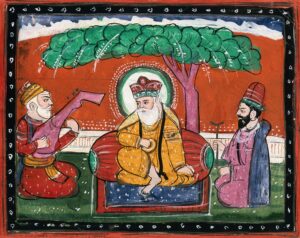Guru Amar Das Ji was born on May 5, 1479, in the village of Basarke near Amritsar, in present-day Punjab, India. He belonged to a Hindu Khatri family and was a devout Vaishnavite in his early years, following strict religious rituals and often going on pilgrimages to Haridwar and other holy places. For most of his life, he followed traditional Hindu practices and longed for spiritual truth, but even after years of devotion, he felt something was missing. At the age of 62, a deeply transformative event changed his life forever.
Guru Amar Das Ji’s journey into Sikhism began through a simple yet powerful moment. One day, he heard a hymn being sung by Bibi Amro, the daughter of Guru Angad Dev Ji, who had recently married into Guru Amar Das Ji’s extended family. The divine message in the hymn of Guru Nanak Dev Ji deeply moved him. He immediately inquired about its source and, learning that it came from the Sikh Gurus, he decided to meet Guru Angad Dev Ji in Khadur Sahib. That meeting proved to be life-changing. At an age when most people retire from worldly life, Guru Amar Das Ji began his spiritual rebirth and dedicated himself wholeheartedly to the Guru’s service.
Guru Amar Das Ji served Guru Angad Dev Ji with complete devotion, humility, and discipline for over 12 years. Despite his old age, he would wake up early to fetch water from the river for the Guru’s bath, clean the langar hall, and perform other humble duties without hesitation. His dedication and humility deeply impressed Guru Angad Dev Ji. In 1552, just before his death, Guru Angad Dev Ji passed on the Guruship to Amar Das Ji, making him the third Guru of the Sikhs at the age of 73.
As Guru, he made significant contributions to Sikhism. One of his greatest achievements was organizing and strengthening the Sikh community. He divided the Sikh Sangat (community) into 22 manjis (spiritual districts), appointing devout Sikhs—both men and women—as preachers to spread the Guru’s teachings. This system helped expand the Sikh faith far and wide. He also established new religious practices that further distanced Sikhism from Hinduism and Islam. Guru Amar Das Ji abolished the purdah system, opposed Sati (the burning of widows), and firmly spoke against caste discrimination. He invited people of all castes and religions to participate equally in religious events and social service.
One of Guru Amar Das Ji’s most revolutionary reforms was the Langar tradition. Though started by Guru Nanak, Guru Amar Das institutionalized it. He declared that no one could meet the Guru until they first sat and ate in the community kitchen — this practice was known as “Pehle Pangat, Phir Sangat” (first eat together, then meet). This powerful act broke caste barriers and emphasized equality, humility, and unity among people of all backgrounds.
Guru Amar Das Ji also composed over 900 hymns, many of which are included in the Guru Granth Sahib. He continued the spiritual teachings of the previous Gurus, encouraging remembrance of God’s Name (Naam Simran), honest living, and service to others. He held annual gatherings at Goindwal Sahib, which became a major center of Sikh learning and spiritual activity during his time.
In 1574, sensing his end was near, Guru Amar Das Ji appointed his son-in-law and dedicated disciple, Bhai Jetha Ji, as his successor. Bhai Jetha was later known as Guru Ram Das Ji, the fourth Guru. Guru Amar Das Ji left his mortal body on September 1, 1574, at the age of 95. His long life and visionary leadership solidified the foundations of Sikhism and transformed it into a spiritual movement that actively challenged social injustice and inspired equality, compassion, and devotion.















 Beyond its religious functions, the Gurdwara serves as a hub for community activities, bringing together the Sikh sangat for prayers, kirtan, and community events. The Gurudwara Baba Deep Singh affiliation underscores its dedication to upholding Sikh principles, contributing to the rich cultural tapestry of the Ganganagar area.
Beyond its religious functions, the Gurdwara serves as a hub for community activities, bringing together the Sikh sangat for prayers, kirtan, and community events. The Gurudwara Baba Deep Singh affiliation underscores its dedication to upholding Sikh principles, contributing to the rich cultural tapestry of the Ganganagar area.